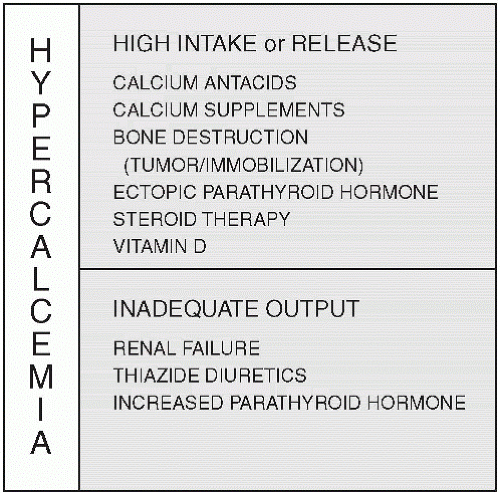Hypercalcemia
QUICK LOOK AT THE CHAPTER AHEAD
Hypercalcemia is documented when the serum calcium level rises above 10.5 mg/dL or 5.5 mEq/L. It has few specific findings to its diagnosis. Symptoms tend to overlap those of an underlying disease or cancerous condition. In this chapter we take a closer look at the causes, manifestations, and treatment of hypercalcemia.
Hypercalcemia results when the movement of calcium into the circulation overwhelms the ability of the regulatory hormones or the renal system to eliminate excess calcium ions. Hypercalcemia is documented when the serum calcium level rises above 10.5 mg/ dL or 5.5 mEq/L. Ionized serum calcium levels must rise above 5.25 mg/dL or 2.5 mEq/L for hypercalcemia to exist.
 Hypercalcemia is documented when the serum calcium level rises above 10.5 mg/dL or 5.5 mEq/L. Ionized serum calcium levels must rise above 5.25 mg/dL or 2.5 mEq/L for hypercalcemia to exist.
Hypercalcemia is documented when the serum calcium level rises above 10.5 mg/dL or 5.5 mEq/L. Ionized serum calcium levels must rise above 5.25 mg/dL or 2.5 mEq/L for hypercalcemia to exist.Hyperparathyroidism can be responsible for hypercalcemia due to the increased production of parathyroid hormone, which helps activate calcium from bone (Table 18-1). Another cause for hypercalcemia is the destruction of bone secondary to malignant cells of certain cancers, such
as lung, breast, ovary, prostate, gastrointestinal, and leukemia. Often, the symptoms of hypercalcemia mimic those of the malignancy. The patient seeks medical attention for the symptoms of the undiagnosed malignancy and at the same time receives the diagnosis of hypercalcemia.
as lung, breast, ovary, prostate, gastrointestinal, and leukemia. Often, the symptoms of hypercalcemia mimic those of the malignancy. The patient seeks medical attention for the symptoms of the undiagnosed malignancy and at the same time receives the diagnosis of hypercalcemia.
Table 18-1 Causes of Hypercalcemia
Stay updated, free articles. Join our Telegram channel
Full access? Get Clinical Tree
 Get Clinical Tree app for offline access
Get Clinical Tree app for offline access
Get Clinical Tree app for offline access

|
|---|
